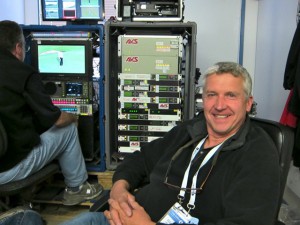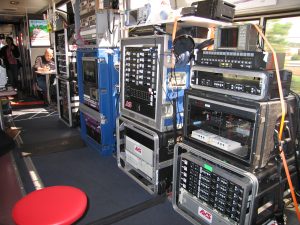SVG Sit-Down: AVS’s Randy Hermes Discusses 40 Years of Innovation, What Lies Ahead
The company provides wireless cameras tech for events from Super Bowls to Oscar shows
Story Highlights
It has been 40 years since Randy Hermes founded Aerial Video Systems (AVS), staking out a unique position with respect to wireless audio and video-signal transport. Since its founding, the company has taken wireless-camera technology to, literally, new heights with projects at Mount Everest, flying cameras on choppers over surfing championships, and, this year, the NBA All-Star Game and Super Bowl LV (as well as numerous entertainment shows). Hermes recently discussed the company’s history, the current state of the wireless video and audio ecosystem, and more with SVG’s Ken Kerschbaumer.
AVS is celebrating 40 years this year, and you got off to a great start with your involvement in the halftime show at the Super Bowl in February. How did that go?
At Super Bowl LV, we provided 19 RF cameras with nine video returns and prompter for a total of 28 RF paths. These were for CBS, the halftime show, NFL Network, and Van Wagner. Our team’s hard work and preparation paid off with flawless shows for our clients, and, when they are happy, we are happy. And being at the Super Bowl and working alongside the rest of the NEP Group was also great.
One of the stories of the halftime show was the use of digital cinema camera rigs and systems, and that’s a lot of what you do. How does the growth of their use in sports impact your opportunities?
We have been doing film-style stuff for quite some time, long before the sports people factored it into production. The biggest challenge for sports is that single camera operators can have a hard time following focus the way you need to with those cameras. For the Super Bowl halftime show with The Weeknd, we put an extra transmitter on the cameras so that a second operator could have wireless monitor and focus control.

AVS’s Randy Hermes at the 2012 Open Championship
What’s your recommendation as to what the sports networks and leagues should do when using those systems?
Well, we recently did the NBA All-Star Game for Turner where we had two Steadicam systems with Canon C-500 Mark II digital cinema cameras. This is a large-format, shallow-depth-of-field camera with an advanced autofocus system. While this is an improvement, it is still difficult for the camera operator to frame, zoom, and focus in such a dynamic environment as sports. We are currently collaborating with Canon to develop a wireless-camera–control system, which will take this package to the next level.
In addition, we also provided a third Steadicam rig outfitted with a 3X super-slo-mo Sony P50 and two transmitters. One was a Vislink L1731 HD transmitter for the live direct feed; the second, a 4K HCAM to provide the 3X super-slo-mo. This was a first, and it worked great.
Do you think cinema cameras need to be used in more scripted spots to be fully successful?
Yes, that would be helpful but not likely to happen in live sports. One thing they could do is to just restrain themselves a bit. Let’s say a player scores a touchdown and the cameraman runs out for a very short-depth-of-field shot. I would suggest that, if you are going to be 8 ft. away, you do just that and act as if it is a fixed focal length, where you keep the frame that far away. I think this approach will provide for a better-looking shot with the desired film-style look.
What else do you have coming up?
On the sports side, we are doing quite a bit of boxing and will be working on the NBA Playoffs and Finals. As for entertainment, we will have 12 RF cameras working the upcoming Academy Awards and pre/post show. We also have the Dick Clark ACM Awards and the LAMA Awards on Telemundo this month.
Do you see business stabilizing and coming back?
Things are coming back but different, at least for now. We were thrilled to get the full NFL season in as we provide RF cameras for ESPN, NBC, NFL Network, and CBS. We also did the Grammys, Emmys, and Golden Globes. Again, these shows looked quite different this year, but production made them happen. To their credit, the industry has been nimble.
As you may know, we are the RF-camera provider for The Price Is Right, The Voice, American Idol, Dancing With the Stars, and Masked Singer/Masked Dancer, which employ a great deal of [augmented reality]. All these shows are up and running due to some incredibly talented and creative people behind the scenes.
For your 30th anniversary, you released a great book filled with photos from the 30 years, and it was cool seeing the evolution. Will you have another book for the 40th?
I’m not sure about that. Going through 30 years of pictures with each one telling a story took an incredible amount of time. The last decade has been focused on HD and 4K and perfecting those technologies. Maybe we’ll wait for the 50th.
Looking to the future, we have a number of transmission technologies and things like 5G. What’s your sense of what’s ahead?
We are keeping our eye on the 5G push, but, for now, it’s vaporware and really doesn’t exist in our world. As an RF company, we do not want to depend on someone else, but, like the rest of the industry, we must be agile.
In general, do you see a bandwidth crunch in the future?
If the tech companies had their way, we would have little to no frequencies available. So, yes, we are being squeezed, and there are and will continue to be confrontations over this finite commodity. For virtually all our shows, we coordinate military frequencies with AFTRCC and the FCC. This is costly, but a clean signal is worth its weight in gold in the RF world. We also use frequencies in the 7 GHz band, which is also under assault.
How has your company grown in 40 years?
I honestly didn’t sit down 40 years ago and map out a long-term strategic plan for AVS. It was more of a natural evolution. I knew we wanted to focus on quality not quantity and be the best at what we do. Slow natural growth was our guiding principle. That principle along with some wonderfully loyal clients have permitted us to buy more equipment and employ very talented people, which in turn has led to our growth.
Also in 2019 we were acquired by NEP Group and that has really allowed us to take things to another level with respect to innovation and serving our existing clients as well as having a chance to meet new ones.
Was there a key deal or moment when you knew this was going to stick?
I always knew that, with hard work and the passion I have for this business, it would work out, or stick as you mentioned. Yes, there were some sleepless nights, but I knew we would be successful. Now 40 years into it, with a strong and dedicated team, I am much more relaxed.
There were shows like the ascent of Mount Everest in 1983, which was truly amazing, historic, and extremely complicated. If we didn’t prepare properly with the right equipment, spare parts, and knowledgeable crew, we could have compromised the entire show. It was like a NASA project, where you must plan everything to the last-minute detail. Keep in mind, at nearly 30,000 ft. on top of that mountain, you can’t think straight, much less bend your fingers.

The extensive AVS setup for support of a week-long train trip for Good Morning America
Another memorable project we did was during the 2008 election with [producer/director]Roger Goodman. We spent five days with Good Morning America live on a moving train going to various locations in the Northeast, stopping in towns and interviewing political candidates and citizens, along with [covering] concerts. We had 11 RF cameras, 17 RF IFBs, 10 RFPLs, 36 RF mics, and three helicopters beaming live from the train to hopscotching uplinks to New York. We literally had planes, trains, and automobiles. Roger was always pushing the limits and thinking out of the box. He was also the first to implement the use of RF cameras on the Academy Awards, which continues today.
Where do you see technology heading in the future with increased deployment of smaller cameras and consumer technologies?
Nowadays, it seems like anybody can do a show with DSLR cameras or even mobile phones. We are now seeing the mini still cameras being used as main cameras for football and basketball. With the availability of off-the-shelf equipment producing some quality product, lots of people are jumping into the fray. We were the first in 2005 to use an HD wireless system on a live Monday Night Football game, and now it is totally commonplace. Our job is to stay out front by creating new firsts, whether it be live HD wireless, adapting the Sony P-1 camera for Steadicam, the HelmetCam for the WLAF in 1991, or the first live wireless 4K system for the 2018 Rose Parade coverage. We will continue to innovate as we have the past four decades.
